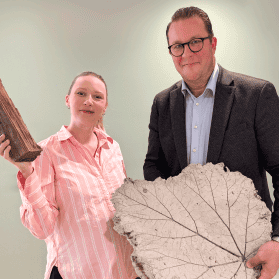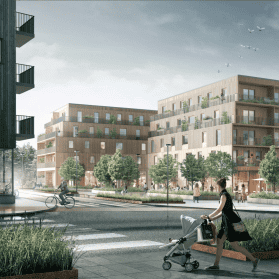When additional environmental impact categories, such as biodiversity, are included in life cycle analysis calculations, wood comes out ahead of concrete. This is shown in the first part of Sveafastigheter’s Wood vs. Concrete study. The study is based on two nearly identical apartment buildings that Sveafastigheter plans to construct – one with a wooden frame and the other with a concrete frame.
With the Wood vs. Concrete study, Sveafastigheter aims to gain a broader perspective on sustainability when choosing frame materials. The study is divided into five parts. The first part adds more environmental impact categories to the life cycle analysis of the frame. Later parts will focus on method development and an in-depth study of biodiversity, an assessment of the working environment at each construction site, a life cycle analysis of the completed buildings, and a survey of tenant satisfaction in the two buildings. The overall results are intended to help the construction and real estate industry make more informed choices. The first part is now being published.
– In the construction and real estate industry, we mainly calculate carbon dioxide emissions, but other environmental impact categories, such as biodiversity, have generally not been considered in new construction. Since the loss of biodiversity is one of the most urgent challenges facing the planet, we need to include it in our analyses when choosing building materials, says Patrik Schön, Head of Construction at Sveafastigheter.
In other industries, established methods exist for quantitatively measuring the effects on biodiversity – but not in the construction and real estate industry, until now. In the first part of the study, Plant, a software company that provides climate calculations for the construction and real estate sector, has collaborated with Chalmers to include additional environmental impact categories.
– We have now measured the impact of building materials on biodiversity using Swedish land data, combined with additional environmental impact categories, to gain a more comprehensive understanding of the whole picture. I believe we are the first on the market to do this, says Astrid Berglund, report author and Sustainability Strategist at Plant.
Housing companies have often focused on promoting biodiversity during the management phase, for example through wildflower meadows and insect hotels. When the impact of building materials on biodiversity has been studied, it has generally been limited to land use during material extraction.
– By using the ReCiPe LCA model, we include more parameters than just land use. This provides a more comprehensive picture of today’s most commonly used materials and delivers entirely new results. At Plant, we are now conducting life cycle analyses of biodiversity and will also integrate this into our software, enabling buildings to be designed and optimized based on their impact on biodiversity, says Astrid Berglund.
The second part of the Wood vs. Concrete study is being prepared by IVL Swedish Environmental Research Institute, focusing on method development and an in-depth study of biodiversity. It will be published later in 2025.
– Part one of the Wood vs. Concrete study gives us a solid overview of the impacts of wood and concrete, with wood coming out on top. We now look forward to the methodology development and the in-depth biodiversity study to see whether the results from part one remain consistent, says Patrik Schön.


